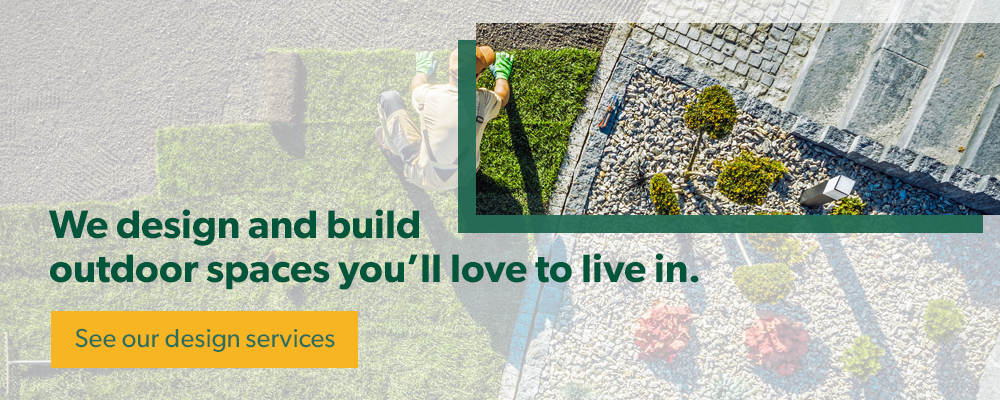Design. Build. Maintain. Grow. At Wright Landscape Services, those four words are more than just a tag line; they are the rules that govern how we work. But what do they mean for you? How does Design & Build work together to create the backyard of your dreams? In this blog, we look at the ways that landscape design and landscape build go hand in glove.
What is landscape design?
For many homeowners, landscape design is nothing more than deciding where to put gardens and planting, backyard patios, and other elements into their outdoor living spaces, but it’s much more than that.
Professional landscape design is about the creation of holistic relationships to connect separate features in your backyard to create an enjoyable living space that both looks good and is functional and liveable.
Landscape design focuses on four key elements to ensure the successful creation of holistic relationships. These four elements are;
-
Harmony:
professional landscape design works to make sure that individual elements and features work together when viewed as a whole. Rather than a water feature here and a privacy wall there, landscape design brings these disparate elements together to create a functional, liveable space.
-
Balance:
when it comes to outdoor spaces, natural elements and “engineered” materials must complement each other. Balancing hardscapes like stone pathways, walls, and built structures with softscapes like grass, plants, and other living elements of a yard is a measure of art and science. Landscape design combines these practices to create a natural look and feel that, when done right, goes almost unnoticed. With the right balance, the difference between hardscape and sofscape elements blurs, creating that natural look and feel.
-
Proportions:
An essential element for balance and harmony, backyard design ensures that softscape and hardscape elements are in proportion with each other. Landscape designers ensure that no one thing, like a garden or retaining wall, dominates an outdoor space.
-
Transition:
Virtually unnoticeable when done right, but painfully obvious when done poorly. Transition is the way that separate areas in a yard are naturally integrated. Great transition makes sure these changes are gradual, smooth, and feel natural rather than abrupt, sudden, or awkward.
There are also intentional design elements like raytracing (establishing lines), focal point perspectives and colour theory that add extra dimensions to backyard design. Landscape design is all about taking the idea that’s in your imagination and making it into a workable, logical plan.
As we’ve already said, great landscape design (like any design) often goes unnoticed, and that’s the point. When done well, an excellent design seems natural, like it’s just the way it was and always will be.
Let’s look at it this way: How many times have you visited someone’s backyard and found that things don’t seem right. You don’t need to be a trained designer to recognize that things seem off. You might notice key indicators like:
- Colours don’t compliment each other
- Designed elements (such as an outdoor dining area or patio) are placed in odd locations, just two or three steps too far or too close to the house
- There is a weird amount of space and empty yard. Perhaps space is just not being utilized properly. Maybe it’s a weird flower bed in the middle of a natural walkway.
To make the most of your yard and outdoor living spaces, choosing the right designer can make a world of difference. Learn how to find the right landscape designer for your project.
From landscape design comes the next part; landscape build. This is where the rubber hits the road, and the design comes to life. However, not any old build will do. To make sure that a design is implemented correctly, it’s crucial to know that the build process is fully committed to the design plan.
What is landscape build?
On the surface, landscape building involves a lot of dirt, rocks, machinery, tools, and mess. But it’s much more than that.
To properly bring your landscaping design to life, many things need to take place before the vehicles and workers get started:
- Permitting: Does your project require local permits? If so, where and how do you acquire them?
- Infrastructure: Will your design (such as a waterfall or pond) impact current water sources (like pipes or irrigation) or need new ones altogether?
- Logistics: Is it even possible for the landscape design to be built properly, or do modifications need to be made?
Once those questions (and many more) are answered, a reputable landscape build team must develop a plan to meet the design objectives and create an amazing outdoor space.
The landscape build plan usually includes things like:
- Creating timelines and schedules
- Reporting on the potential impact on other areas of your property
- A strategy to reduce the risk of damage to surrounding properties
- How to address impediment issues for street and sidewalk traffic, including considerations for fire hydrants, walkways, or driveway access
- Ensure space is available to deliver, store and grab materials safely
Once this plan is created, the build can begin. At this point, your landscape design starts to take shape during as design and build come together to create something special.
Why landscape design & landscape build go together
It seems obvious. You can’t build a project without designing it. And it makes no sense to design a project if it can’t be built. But it’s much more than that.
Look at your grandmother’s chocolate chip cookies. No matter how many times you follow her recipe to the letter, they never turn out as tasty as hers. That’s because she originally designed the recipe and then built (or bake) it to perfection. We can consider this a holistic approach where the design and build were equal parts of the same process. The intention to bake (build) and design (create a recipe) was one effort.
Just like the cookie, by having one company handle the design and build aspects of your project, you know it will turn out exactly how you want it. The intention is for these processes to be part of the same effort.
Sure, you can have company X design your outdoor living space and company Y build it, but there’s a good chance something will get lost in translation:
- Maybe the natural stone and interlocking design won’t be quite right for the backyard
- Perhaps the lighting won’t be pointed in the right direction creating “blind spots” in the evening
- Possibly grass cutting the backyard will be too difficult due to tight corners or narrow access
It might come close, but it won’t be perfect.
So – just like grandmother’s perfectly chewy chocolate chip cookies – it’s best to have a single company plan and execute your landscaping project. That way, design and build work together to create the final product.
The team at Wright Landscape Services consists of, certified landscape designers, project estimators, landscape build technicians, and design-build supervisors and lead hands. All of these people working towards the same goal means all aspects of your project – from conception to construction – are handled by a full-service staff, involved in the project from start to finish.
That’s how it should be.
If you’re ready to take your yard from blah to bliss, we’d love to help!
Download our our backyard design checklist and start planning the backyard of your dreams!
Still looking for some inspiration? We’ve got you covered with a free lookbook.

Ready to make your dreams come true?
Learn our planning secrets and get started with turning a yard redesign into a reality.
- Budgeting tips
- How to set priorities
- What to ask your architect

